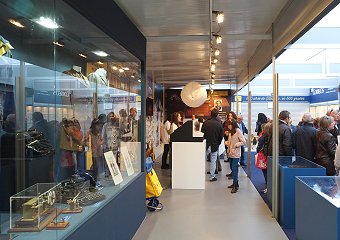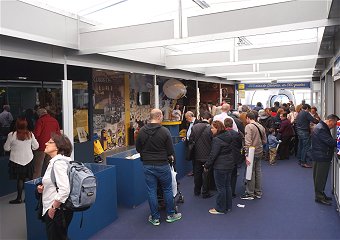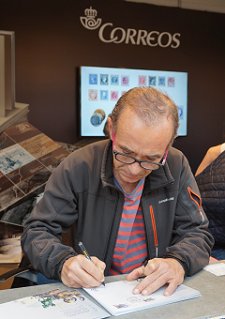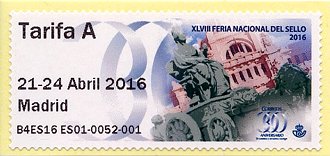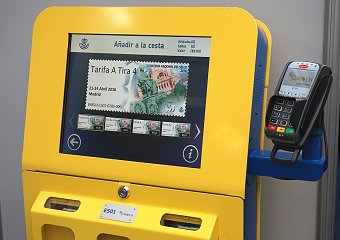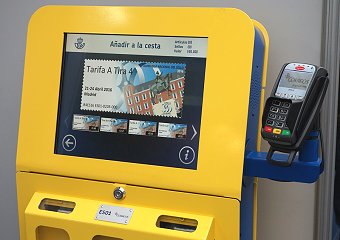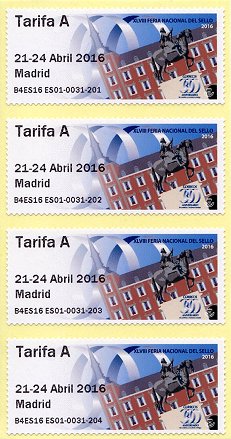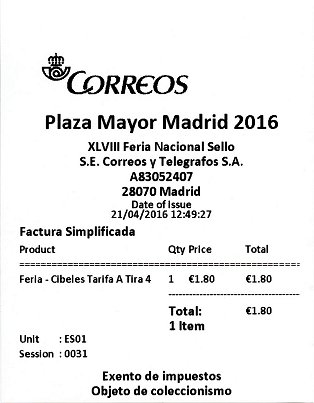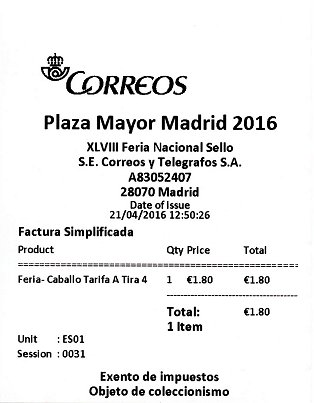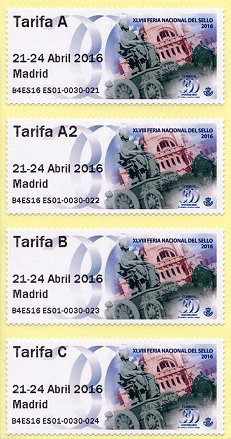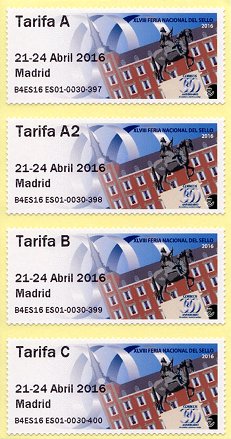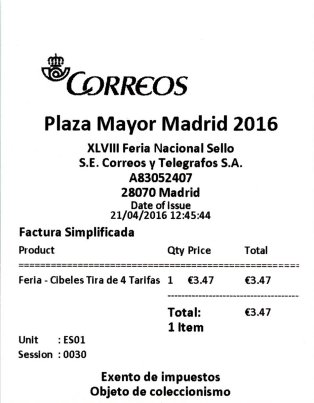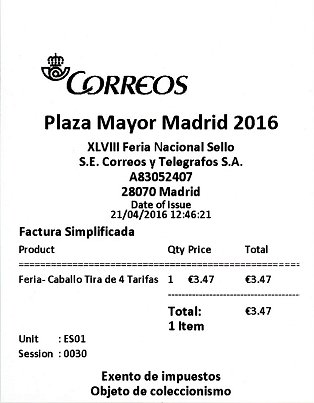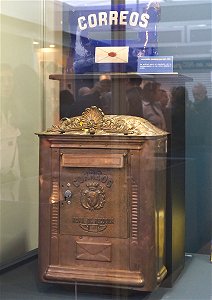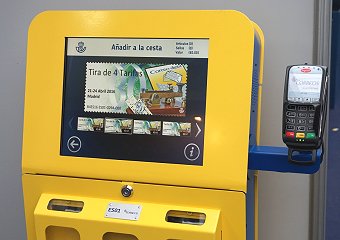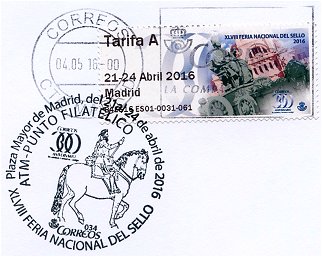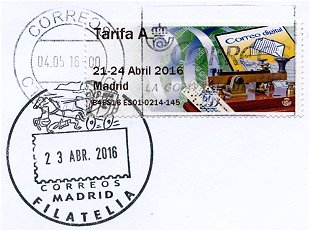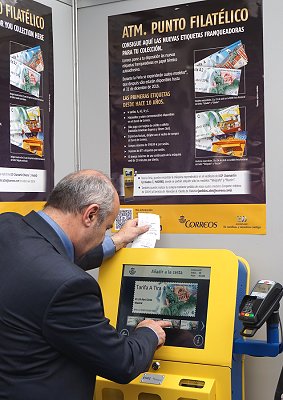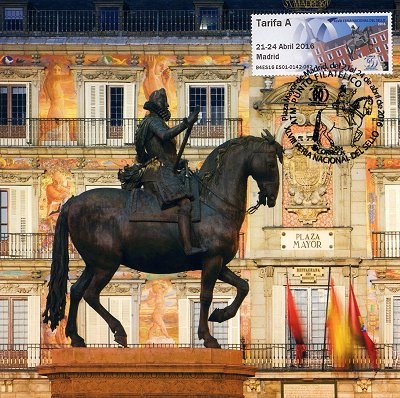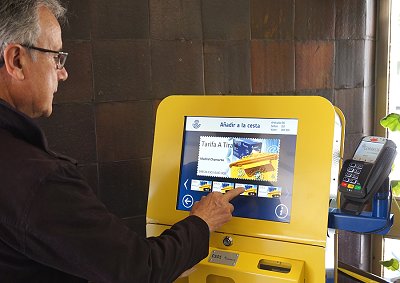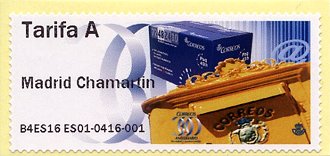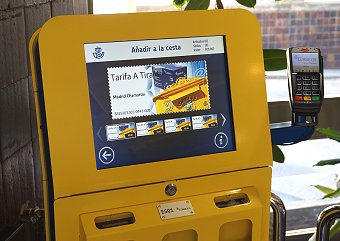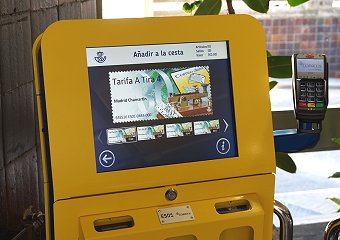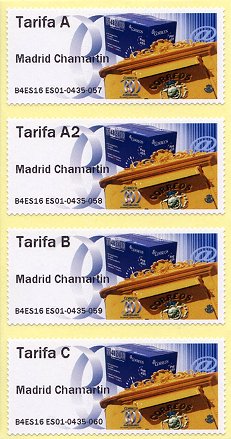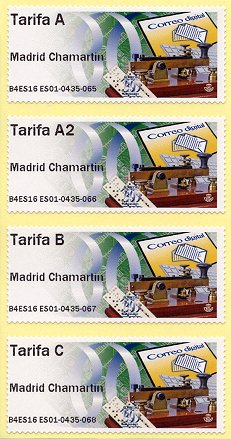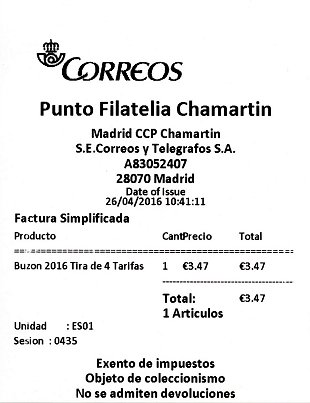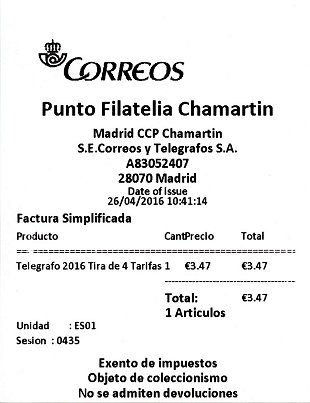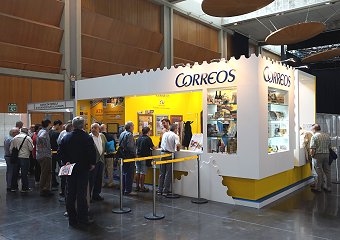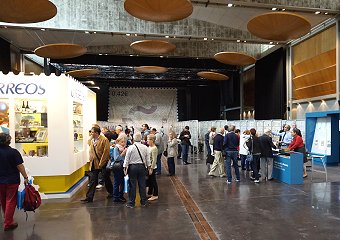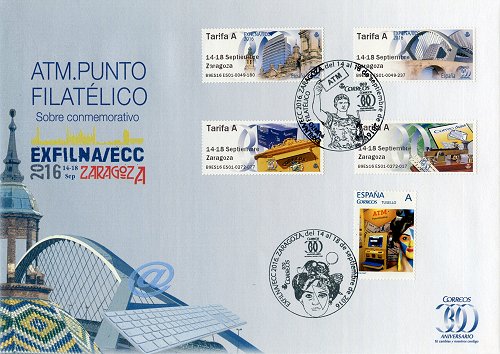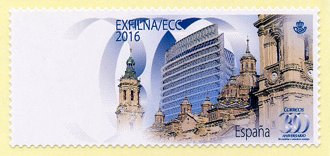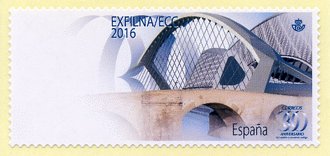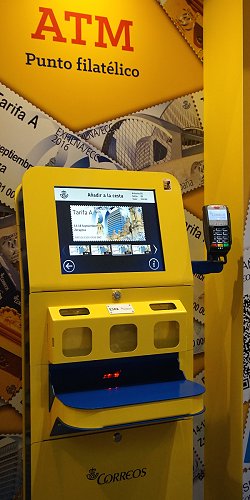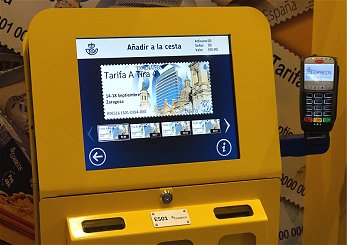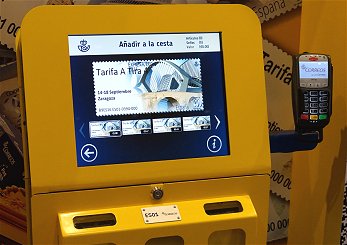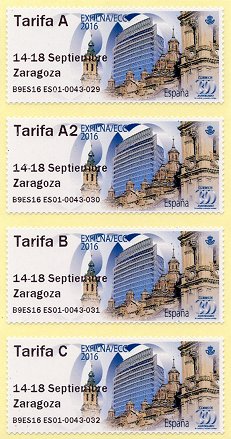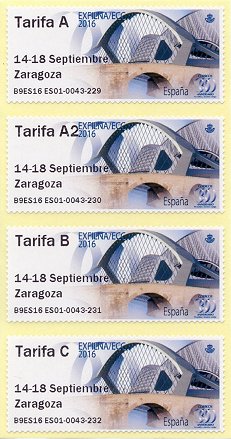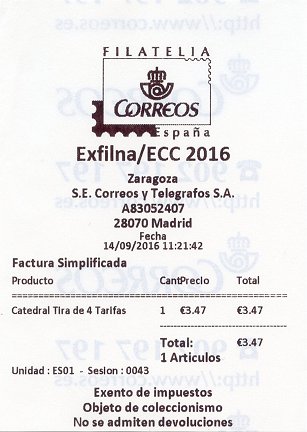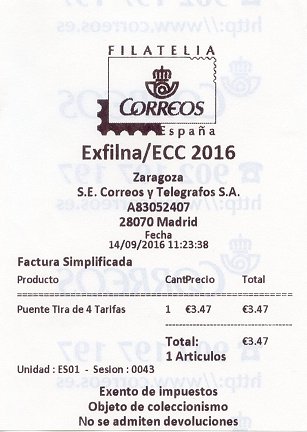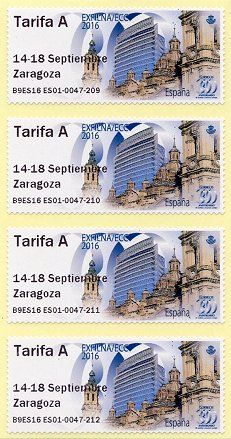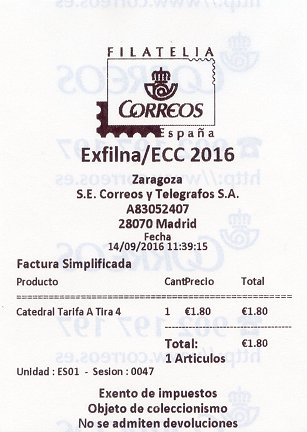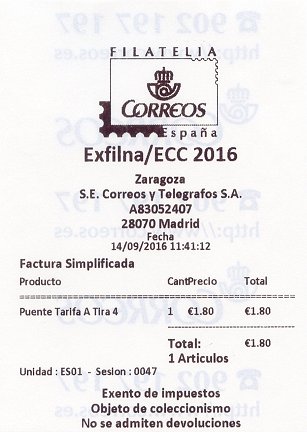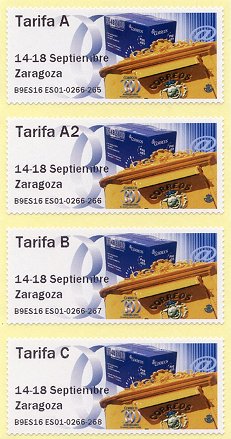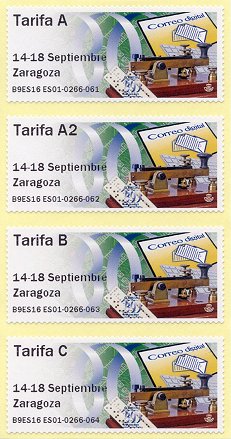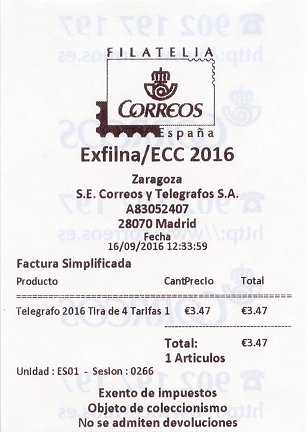| XLVIII Feria Nacional del Sello 2016, the ATMs return to Spain |
Collectors of variable value stamp of Spain have reason to celebrate. After nearly 10 years without any new designs, Correos – the Spanish Post decided to acquire a new philatelic kiosk and put it into service at XLVIII Feria Nacional del Sello, in Madrid, the major philatelic fair of Spain.
Feria del Sello is a great annual Correos commitment to make visible philately and the world of mail, to the general public. Perfectly located in the Plaza Mayor of Madrid, one of the busiest places in the capital, the Fair attracts, over a weekend, thousands of visitors of all ages, interested in philately or not, as well as passing tourists.
In 2016, the 48th stamp fair was held from April 21st to 24th. It was organized by the Sociedad Estatal Correos y Telégrafos, S.A., with the collaboration of ANFIL (the national association of stamp and coins dealers) and Fábrica Nacional de Moneda y Timbre (Spanish Mint).
The Fair was held in a very open and accessible large temporary pavilion, opposite the Casa de la Panadería (image). |
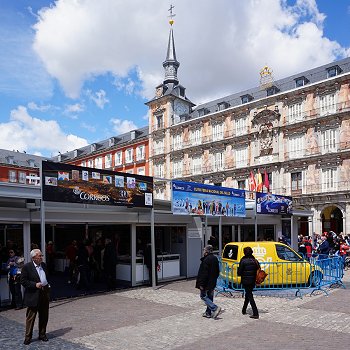 |
 |
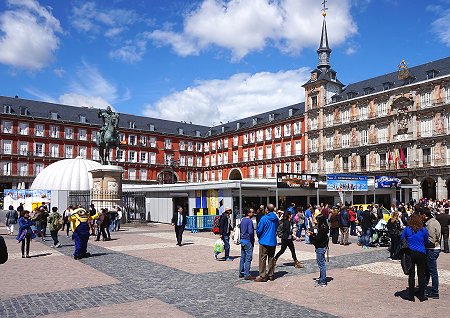 |
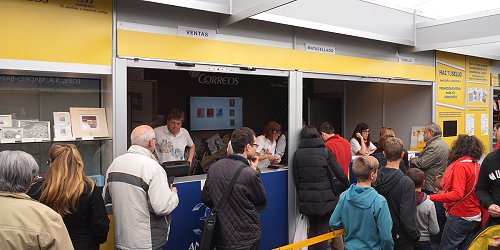 |
Inside, the pavilion housed twenty booths (including one hosted by ATEEME), plus the institutional stands of Correos (left images), always crowded, ANFIL, and Real Casa de la Moneda - FNMT (the Spanish Royal Mint). For the second year, the organization gave a booth to the philatelic service of a guest country, Germany. |
 |
The previous Fair was dedicated to the world of dinosaurs (see article, also published in VARIABLE 37), whilst the 2016 event commemorated the 300th anniversary of the mail in Spain, with special issues and releases, and exhibitions of different postal items loaned by the Madrid Postal Museum. In an inflatable dome were projections related to the history of the mail and the organization scheduled different activities for visitors.
Directly related to our field of study, Correos introduced the new philatelic kiosk, called 'ATM. Punto Filatélico', which issued variable value stamps with four different designs, during the Fair.
The machine was installed next to the main exhibition area, in front of our stand (right image). Good decision or lucky coincidence ??, since we decided to participate, for the first time, in the Madrid Stamp Fair ... That important presentation deserved it ! |
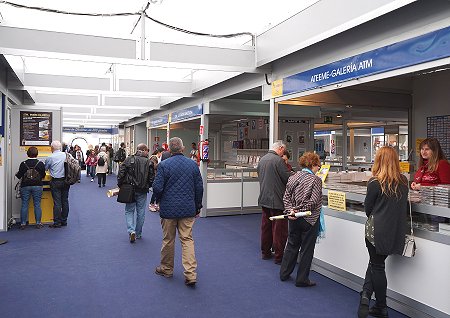 |
The model of kiosk installed in Madrid is a self-service stamp vending machine originally developed by the British company Intelligent AR, for Royal Mail.
After its presentation at the London Spring Stampex 2014 (see article, also published in VARIABLE 32), and in just over two years, about thirty kiosks have already been installed, and we can expect this number to grow exponentially in the coming years. At present, most of the machines are installed in the UK, but also are used by the philatelic services and the postal administrations of Gibraltar, Guernsey, Jersey and Qatar.
On this website and in earlier VARIABLE issues, we have published dozens of articles on these machines and their issues (called 'Post&Go'), in different countries.
| The new Correos kiosk is the first fully customized machine, with the colours, yellow and blue, and the corporate image of the postal administration. It belongs to a new batch of kiosks that can be easily recognized by the smaller rectangular base, the same width as the kiosk, rather than the larger rounded base of the earlier machines. |
 |
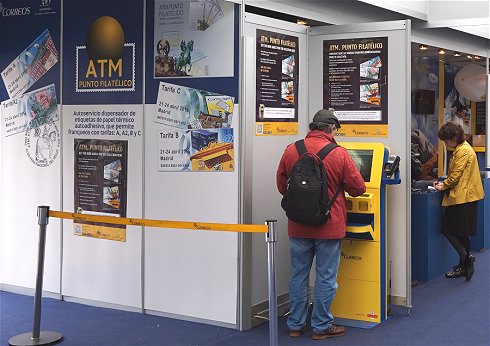 |
The kiosk has a simple compact design, with a LCD 17-inch touch screen and a card payment unit, the only payment option available, at the top. Under the screen, a case protects the exit of the stamps and receipts, which, after cutting, are placed in the lower tray.
The kiosk is fitted with three Fujitsu direct thermal printers, which include a cutter. The two side printers are used for the printing of stamps, and the one in the middle is for receipts. Therefore, the machine allows the stamps to be printed from two different rolls of labels.
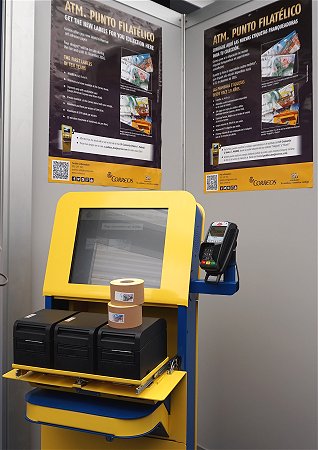 |
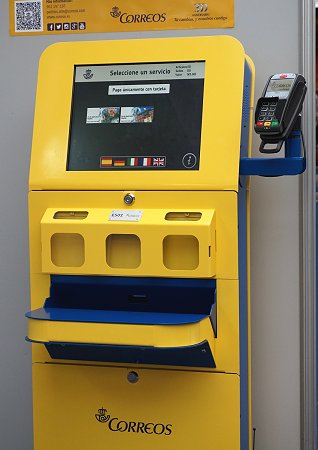 |
For the printing of the stamps, the machine uses rolls of 1,500 self-adhesive thermal labels manufactured by Cartor Security Printing and printed digitally. These labels have the same size and characteristics as the 'Post & Go' issues produced for other countries using this type of kiosk. The size is 56 x 25 mm. and has perforations resembling 'traditional' stamps.
Surprisingly, none of the first four designs includes the mandatory name of the issuing country, 'España', which is required for international mail, and there is only a small logo of Correos and its Tercentenary.
Correos requested Cartor to include, for the first time, a pre-printed number on the back of each label, on the silicone paper, for inventory control. This number shows the number of labels remaining on the roll. |
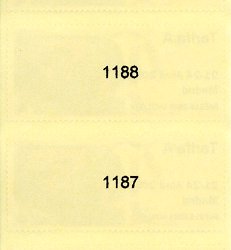 |
Correos decided that the new kiosk would issue variable value stamps with four different designs, during the Fair, two special designs dedicated to the 48th National Stamp Fair during the first two days, and two other designs dedicated to the 300th Anniversary of Correos over the last two days.
| All the designs are by Juan Antonio González (image below, in an improvised signing session during the Fair), a designer in the Correos philatelic department, who is also the author of the designs of the pictorial cover released by Correos, and the special postmarks for new ATMs and the Fair’s general postmark (right). |
 |
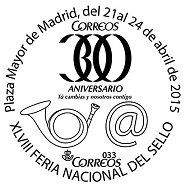 |
| In April 21st and 22nd, the machine issued variable value stamps (ATMs) with two designs featuring emblematic monuments of the capital. The Cibeles fountain in front of the former Palace of Communications (now Palacio de Cibeles and the new Madrid town hall), and the statue of King Felipe III in Plaza Mayor (the location of the stamp fair). The Tercentenary logo is also included in the background designs. |
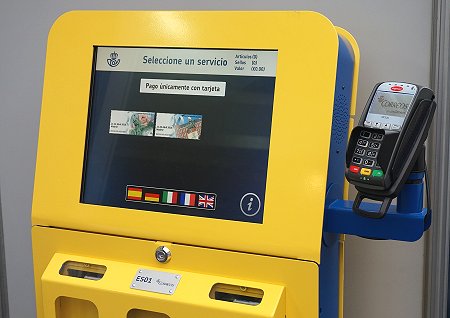 |
 |
After selecting the design on the main screen, the kiosk issues variable value stamps with the four basic postal rates A, A2, B and C, plus strips with four 'Tarifa A' stamps (first block of stamps and receipts, below), and strips with the four-value set (next block below).
These face value indicators correspond to the domestic postal rates for letters up to 20 and 50 g, and the rates to European countries and the rest of the world up to 20g., respectively.
Thus stamps with four different face values can be obtained for each design. |
Labels include a white area at the left of the preprinted design allowing the thermal imprint of the different data at the time of issue. In the case of the stamps issued during the Madrid Stamp Fair, the indicator of face value, the special temporary imprint '21-24 Abril 2016 Madrid' and, on the bottom of the label, a unique alphanumeric code for each stamp formed by four blocks. In the first block, 'B' indicates that it is a philatelic issue, '4' for the month of issue (April), 'ES' for the country where the issue was printed (Spain), and '16' for the year of issue. The second block corresponds to the machine code (ES01). This code can also be seen on the small plate below the screen, on the metal case of the kiosk. The third block of four digits corresponds to the session number, followed by a block of three digits indicating the stamp number within the purchase transaction.
Along with the stamps, the kiosk issues, automatically, receipts corresponding to the strips of four 'Tarifa A' stamps and the sets with the four postage rates, plus a summary receipt with all the stamps acquired, and another receipt for the card payment.
During the Fair, some of the words included in the receipts appeared in English. Receipts include extensive information about the purchase, and they are an interesting complement for the collection.
The printing of the face value and other information on the stamps and receipts is thermal direct, the same type of printing used by Epelsa franking scales and kiosks, although Cartor manufactures the labels on high quality thermal paper, ensuring better printing conservation.
On April 23rd and 24th, the kiosk issued variable value stamps (ATMs) with two designs dedicated to the 300th Anniversary of Correos, with postal motifs and the Tercentenary logo.
The first design features an old wall mounted postbox and a current mail box. The postbox was exhibited in the stamps fair, just behind the kiosk (image below, right).
The second design features an antique telegraph, also exhibited in the Postal Museum, with a punched card, and an image relative to modern digital mail, with a computer keyboard. |
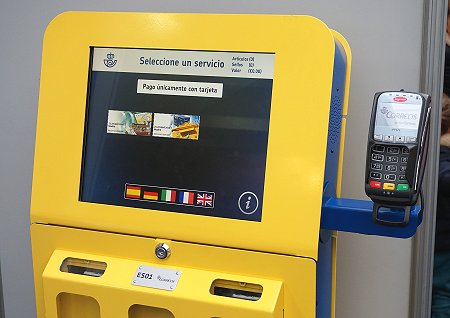 |
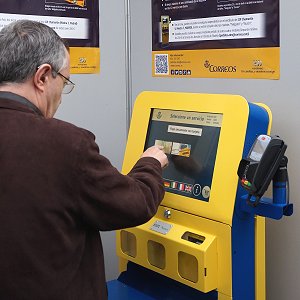 |
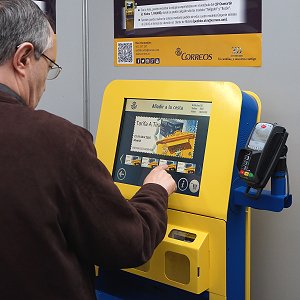 |
Design selection screens, and selection of the face value or strip required. |
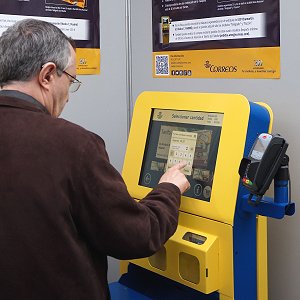 |
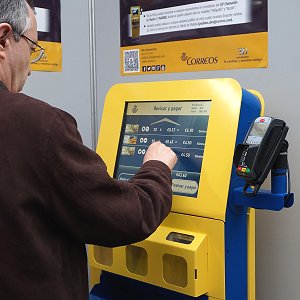 |
Quantity selection, and list of all the stamps requested, before payment. |
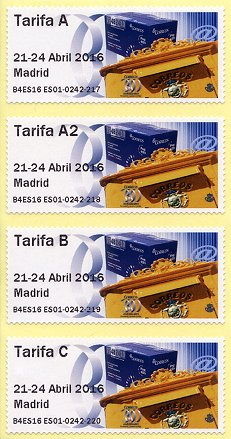 |
 |
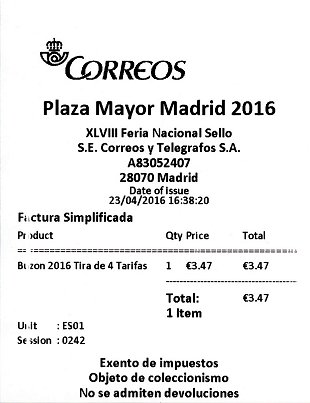 |
 |
| Receipts issued from April 23rd include the indication 'No se admiten devoluciones' (No refunds are allowed) in the bottom line |
Although the machine had been tested on the Correos premises a week before the fair opening, the kiosk had some problems with the payment module and software during the fair, and it was out of service for some periods. The machine was installed on the day before, in the evening, but because of the delay in the preparation of the fair (in fact, the opening was delayed two hours), it was not started up and tested until the morning of the 21st.
The rush to launch the equipment without the relevant tests under real conditions of intensive use did not help. Still more bearing in mind that changes could only be remotely performed, and that the software was originally conceived and developed for the English speaking area.
On Saturday 23rd, problems with remote software changes, because of the introduction of the two new designs and various modifications requested by Correos, delayed for several hours the start of the issue.
Even so, the machine aroused great curiosity and interest among fair visitors and collectors, which created some very busy periods.
|
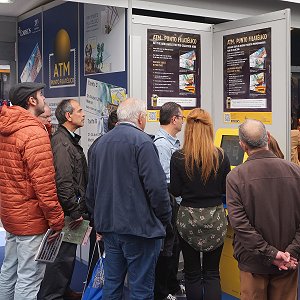 |
Furthermore, all the domestic letters handed in by collectors at the Correos stand during the Fair, for mailing with the new ATMs, were delivered, almost two weeks after the fair, at the Centro de Tratamiento Automatizado (CTA), the Madrid Automated Mail Processing Centre, where the covers received a second mechanical postmark. A serious mistake that caused big disappointment and anger with most collectors.
| The philatelic kiosk at the CCP Chamartín |
After the stamp fair and the hectic weekend, the kiosk was moved to its permanent location, in the Chamartín railway station mail processing centre, in Madrid (CCP Chamartín = Centro de Clasificación Postal).
The equipment was installed in the lobby of the office building, in a complex that also includes the processing centre and Correos branch number 61. |
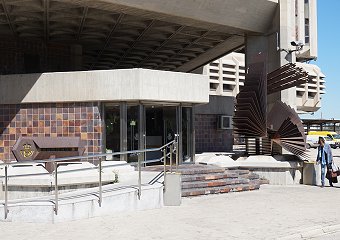 |
 |
The Spanish kiosk is designed for philatelic use. Its features and characteristics, with only four programmed postage rates, and its location in a zone with difficult accessibility rarely visited by the general public, does not favour its postal usage.
So for the time being, the kiosk will be only used by the philatelic service and occasional collectors / visitors. |
In its new location, the kiosk will only issue stamps with the two postal motif designs, dedicated to the Correos Tercentenary. The special temporary imprint on stamps issued during the stamps fair was replaced by the permanent impression 'Madrid Chamartin'.
| The kiosk was installed early on the morning of Monday April 25th and the first tests were made some hours later, in the afternoon. The character set used by the machine did not accept the Spanish |
| accent marks, but showed symbol combinations in the 'Madrid Chamartín' printing of the stamps and in the words including accent marks on the receipts. A remote modification removed all the accent marks, and finally the machine was ready to go from the morning of Tuesday 26th. |
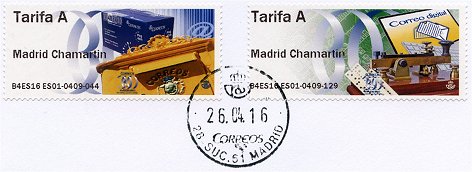 |
| Correos requested some changes in the information included in the receipts, which were arranged during the first two days in service. In an initial version, the special heading for the Feria del Sello was replaced by 'Correos y Telegrafos S.A.E.' and the new location of the machine, 'Madrid CCP Chamartin' (receipt type I). Two hours later, in another modification (receipt type II), the name of the postal operator was replaced by 'Punto Filatelia Chamartin', and some words which still appeared in the English language were translated into Spanish. |
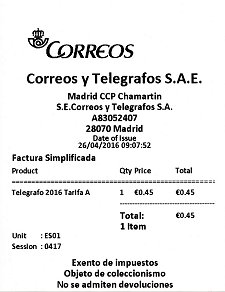 |
 |
| Receipt type I |
Receipt type II |
The last changes were made on the morning of Wednesday 27th (receipts type III). The Correos logo was replaced by the philatelic service logo (IIIa), and the remaining English text, 'Date of Issue', was finally translated into Spanish (IIIb). All the words with no accent marks.
None of these changes affected the printing on the stamps.
Throughout this process, the session number was reset several times. |
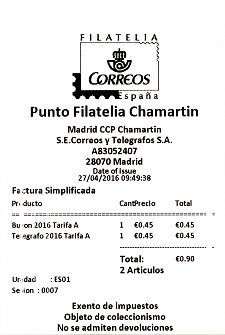 |
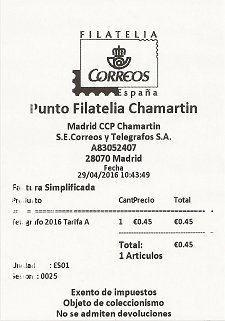 |
| Receipt type IIIa |
Receipt type IIIb |
| The EXFILNA / ECC 2016 issues |
After the introduction of the new philatelic kiosk and the good acceptance of its ATM issues, at the recent Madrid stamp fair (see articles, also published in VARIABLE 41),
the Spanish philatelic service programmed in some new issues for the next major national philatelic event, the EXFILNA of Zaragoza.
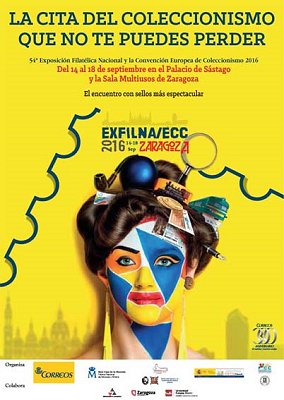 |
The 54th National Philatelic Exhibition, EXFILNA 2016, was held from September 14th to 18th. This annual exhibition is organized by the Spanish Federation of Philatelic Societies (FESOFI), with the sponsorship of the Sociedad Estatal Correos y Telégrafos - the Spanish Post.
In 2016, in addition, this major philatelic and collecting event brought together the 3rd. European Convention for Collectors (ECC), organized by the Asociación Nacional de Empresarios de Filatelia y Numismática (ANFIL), and a large exhibition on the 300th anniversary of Correos. |
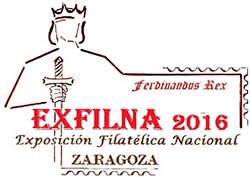 |
The exhibition and the different activities were developed at two sites, the Palacio de Sástago and the multipurpose hall of the Auditorio Municipal.
Correos also planned to install a large inflatable dome for displays in the Plaza del Pilar, but due to weather conditions it was not possible to install it.
In the Palacio de Sástago (right image), in the city centre, Correos installed an exhibition commemorating its 300th anniversary, showing the 300 best stamps of Spanish philately organized by themes, with explanatory panels, and displayed in showcases along with various related items (images below). A great exhibition, in an exceptional place, that attracted thousands of visitors during the five days of the fair. |
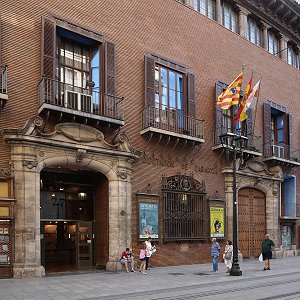 |
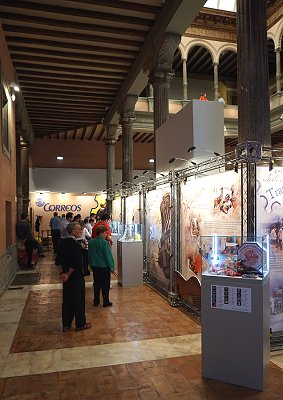 |
Another great success was the philatelic outlet next to the always crowded Correos commercial and postmarking booth.
In an adjoining room, FESOFI installed the collections included in the EXFILNA Championship Class.
The Palace also hosted the different seminars and stamp presentations scheduled during the fair. |
 |
| The frames of the EXFILNA competitive philatelic exhibition were installed in the large multipurpose hall of the Zaragoza Municipal Auditorium (right image), next to the commercial booths of the Third European Convention for Collectors (ECC), and the institutional stands of CORREOS, the Real Casa de la Moneda - FNMT (the Spanish Royal Mint), ANFIL, FESOFI and the Universidad Europea of Madrid, which held demonstrations of 3D postmark printing. |
 |
 |
In the centre of the large hall, the organization placed the 3D reproduction of a large size King Felipe VI stamp, printed by the Universidad Europea.
At one end, the large mosaic with 230,000 stamps, promoted by Correos, in 2014, showing a Spanish 'Ñ', and exhibited here for the last time (left image).
The organization also installed various large exhibition showcases displaying other types of collectibles. |
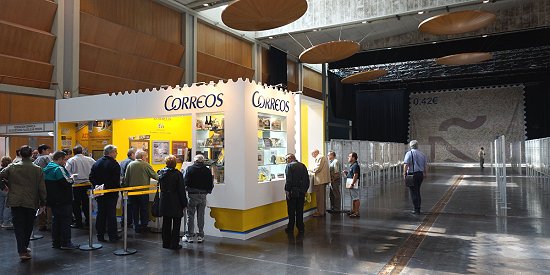 |
Correos produced various philatelic issues related to this event. Among them, a souvenir sheet, issued in February, featuring the poster. During the exhibition, Correos launched an issue dedicated to the Palacio de Sástago and another commemorating the 500th Anniversary of the death of Fernando el Católico, as well as two new designs to be issued by its ATM philatelic kiosk.
| Correos moved its brand new kiosk to Zaragoza, where it was in operation during the five days of the fair. The machine was placed at one end of the philatelic service stand in the multipurpose hall, perfectly integrated into the booth's design, along with a computer system allowing the printing of personalized stamp sheets (see first day cover, below). |
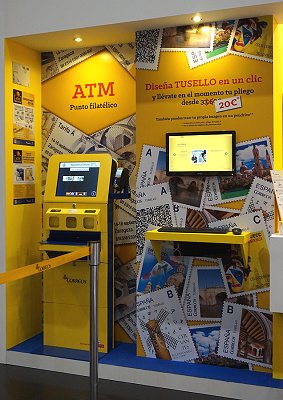 |
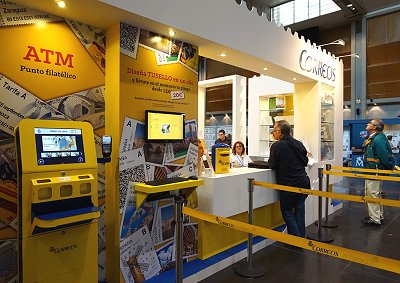 |
As happened in the Madrid stamp fair, Correos decided that the new kiosk would issue variable value stamps with four different designs, during the Zaragoza event. Three days with the two new special designs dedicated to the EXFILNA / ECC 2016, and two days with the two other 'definitive' designs featuring postal motifs. All the stamps issued in Zaragoza include the special imprint '14 -18 Septiembre Zaragoza'.
The designs of the issues are by Juan Antonio González, a designer in the Correos philatelic department, who is also the author of the designs of the pictorial cover released by Correos, and the special postmarks for new ATMs and the Fair’s general postmark (images below).
The kiosk uses rolls of 1,500 self-adhesive thermal labels manufactured by Cartor Security Printers, printed digitally and with the same size and characteristics as earlier issues. All the labels are numbered on the back, on the silicone paper, for inventory control. At the beginning and at the end of the roll, the manufacturer added strips with no labels, with 'xxxx' on the back (strip below, right), which allows printers to optimize the rolls and print on all labels.
On September 14th, 15th & 17th, the machine issued variable value stamps (ATMs) with two designs featuring different Zaragoza's monuments and landmarks.
Unlike the four designs launched in Madrid, the compulsory name of the issuing country, 'Spain', already appears on the new issues. |
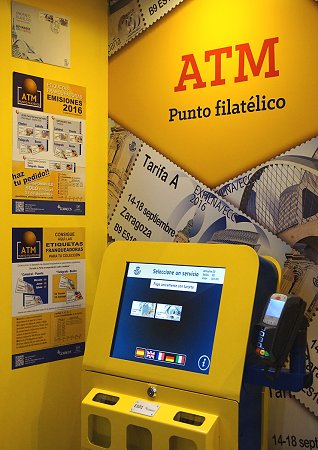 |
 |
| The first design, called 'Catedral' on the receipts, shows a detail of the Catedral-Basílica de Nuestra Señora del Pilar rooftops (maximum card below) and, in the background, the Torre del Agua (right), one of the iconic buildings built for Expo Zaragoza 2008. |
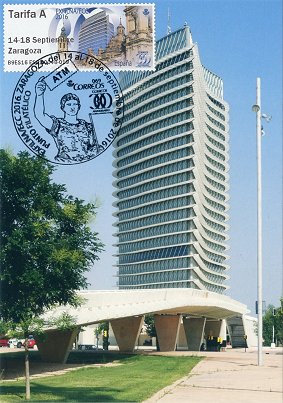 |
 |
 |
| The second design, ('Puente' on the receipts),features a superimposition of three bridges. In the foreground, the Puente de Piedra (upper maximum card), a Gothic bridge built in the XV century, the oldest preserved on the Ebro river. Behind it, the modern Puente del Tercer Milenio (right), and the amazing Pabellón Puente by the architect Zaha Hadid (image below and front cover of VARIABLE 42), both also built on the occasion of Expo 2008. |
 |
 |
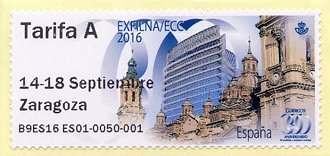 |
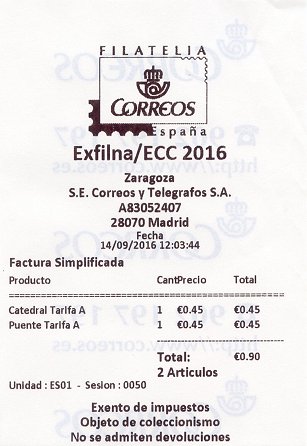 |
 |
| As can be seen in the upper images, labels include a white area at the left of the preprinted design allowing for the thermal overprint of the different data at the time of issue as an stamp. |
In the case of the stamps issued during the Zaragoza EXFILNA, these data are the indicator of face value ('Tarifa A' on the upper stamps), the special temporary overprint '14-18 Septiembre Zaragoza' and, on the bottom of the label, a unique alphanumeric code for each stamp, formed by four blocks. In the first block, 'B' indicates that it is a philatelic issue, '9' for the month of issue (September), 'ES' for the country where the issue was printed (Spain), and '16' for the year of issue. The second block corresponds to the machine code (ES01). The third block of four digits corresponds to the session number, followed by a block of three digits indicating the stamp number within the purchase.
Along with the stamps, the kiosk issues, automatically, issues receipts corresponding to the strips of four 'Tarifa A' stamps and the sets with the four postage rates, plus a summary receipt with all the stamps acquired, and another receipt for the card payment. In Zaragoza, the kiosk printed receipts on rolls of low quality thermal paper, with the Correos logo printed on the back (right image). |
 |
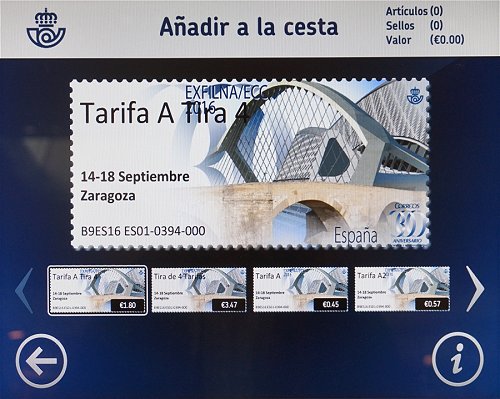 |
After selecting the design on the main screen, the kiosk offers variable value stamps with the four basic postal rates A, A2, B and C, plus strips with four 'Tarifa A' stamps ('Tarifa A Tira 4' - upper screen), and strips with the four-values set ('Tira de 4 Tarifas' - screen below).
These face value indicators correspond to the domestic postal rates for letters up to 20 and 50 g, and the rates to European countries and the rest of the world up to 20g., respectively.
Thus stamps with four different face values can be obtained for each design (see strips and receipts below). |
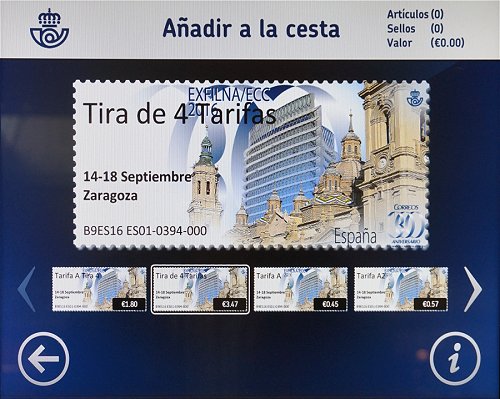 |
On September 16th & 18th, the kiosk issued variable value stamps (ATMs) with the two 'basic' designs presented in Madrid, illustrated with designs dedicated to the 300th Anniversary of Correos, with postal motifs – identified as 'Buzón' & 'Telégrafo' ('Postbox' & 'Telegraph') on the receipts.
Also these designs were issued with the special temporary overprint '14-18 Septiembre Zaragoza'. |
 |
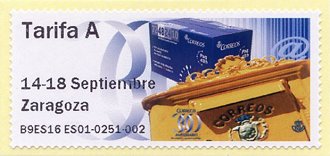 |
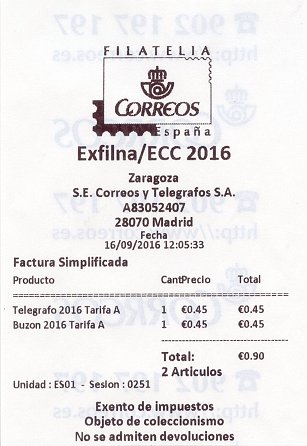 |
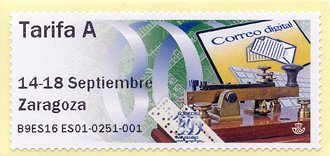 |
Right. First day receipt issued by the purchase of the two stamps for domestic mail - Tarifa A
Below, sets with the four programmed values and the corresponding first day of issue receipts |
| The issues of the Philatelic Service |
In September 2016, to meet collector demand and to have the opportunity to sell these issues at the different international philatelic fairs, the Spanish Philatelic Service pre-printed strips of ATMs with the eight different combinations of design and temporary overprints issued at the Madrid and Zaragoza fairs. These stamps were only produced in sets of four values and without receipts.
Unlike the stamps usually printed by the philatelic kiosk in its permanent location and in philatelic exhibitions, with code ES01, the machine code printed at the bottom in these special series is B004. On the other hand, this code does not include the session, nor the stamp numbers.
Until the end of 2016, these sets could be purchased at the Correos booths at PHILATAIPEI 2016 (article) and the 70th Salon Philatélique d'Automne, in Paris (more information).
 |
 |
XLVIII Feria Nacional del Sello 2016
'21-24 Abril 2016 Madrid' |
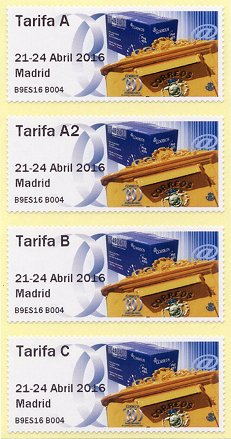 |
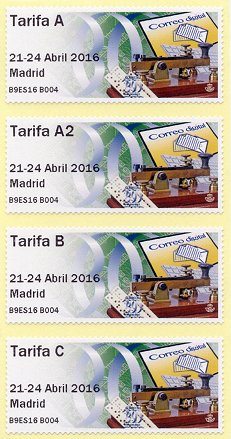 |
 |
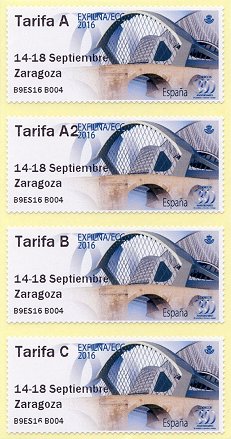 |
EXFILNA / ECC 2016
'14-18 Septiembre Zaragoza' |
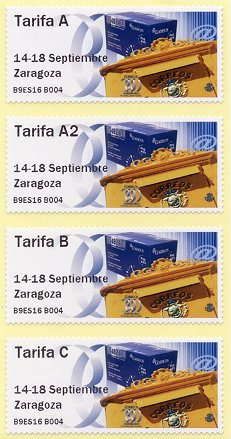 |
 |
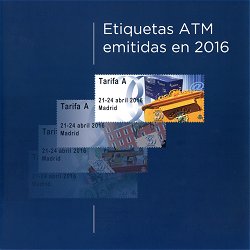 |
At the end of 2016, the Correos philatelic service created an annual standing order for the 'Etiquetas térmicas ATM' (Thermally printed ATM labels).
The stamps included in this standing order are supplied in pictorial folders with all the designs issued throughout the year, as well as information about the different issues. |
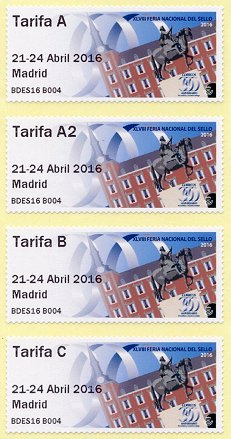 |
In 2016, the six designs appeared in the usual four-value set (Tarifa A - A2 - B - C) placed in protective stamp mounts, with the permanent or temporary imprint programmed in the kiosk on the first day of issue.
Unlike the strips of stamps previously sold by the philatelic service, with the bottom code B9ES16 B004 (see previous article and VARIABLE 42), the standing order stamps were issued in December 2016 and the code is BDES16 B004. The second digit of the code shows the month of issue but from October the month number is replaced by the first letter of that month i.e. O, N or D. |
 |
The contents of this page and the website in general are protected by copyright.
The unauthorized copy of the text and / or images is prohibited.
ATM Web - Spain and Latin American Postal Services: http://www.ateeme.net
© J. Jove - ATEEME. Variable value stamps study group. All rights reserved
This page was created in April 2016 and last updated:
12.12.17
. English edition rewritten by S. Goodman & J. Gareze
|





